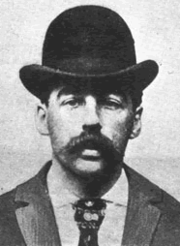America’s First Serial Killer
Most people have probably never heard of Dr. H. H. Holmes of Chicago, but in the annals of American crime his name is significant. What makes his story so fascinating is that it is interwoven with the story of the 1893 Chicago World’s Fair, or, as it is known, the World’s Columbian Exposition.
H. H. Holmes was born Herman Webster Mudgett on May 16, 1861, in Gilmanton, New Hampshire. At the age of twenty-three he graduated from the University of Michigan Medical School. As a student, he had been fascinated with dead bodies and was known to have stolen corpses from the school laboratory. In some cases he was able to claim insurance policies on bodies he had mutilated and made unrecognizable. Upon obtaining his medical degree, he moved to Chicago, where he assumed the name of Dr. H. H. Holmes, found a job working in a pharmacy, and engaged in a variety of shady business, real estate, and promotional activities.
Dr. Holmes established a reputation in Chicago for being a charming and persuasive fellow. He was handsome, smooth, and dapper, and he had a way of winning over—not only women—but men and children alike. Through his good looks and personal appeal, he was able to get whatever he wanted from whomever he happened to be dealing with.
Across the street from the drug store where he was employed (and later owned), he built a block-long building that came to be known in the neighborhood as the “castle.” He designed the building himself; it contained a maze of over one hundred windowless rooms with doorways opening to brick walls, oddly angled hallways, stairways to nowhere, doors that opened only from the outside, and a host of other oddities. He repeatedly changed builders during construction so that only he understood the design of what he had created. He planned on using the building as a hotel for visitors to the World’s Fair.
When the hotel was finished, Dr. Holmes went on a killing spree. He selected many of his victims from among lovers, fair visitors, or people who worked for him. Very often he tortured his victims before killing them. He would lock them in a huge soundproof vault where he would leave them to suffocate, or he would gas them in rooms from which they could not escape, while he looked on through a peep-hole in the door. After his victims were dead, he would dispatch them through a system of chutes to the basement of the building, where he would either burn them or have their bodies stripped of flesh and tissue so he could have their skeletons “articulated” to sell them to medical schools. Through connections he had made as a medical student, he could sell skeletons or organs with little difficulty.
He had two giant furnaces in which he could cremate bodies without detection and also pits of acid in which he could dissolve them. He also used poisons, a lime pit, and a stretching rack. He performed hundreds of illegal abortions, many of which resulted in death. When the victim died, he would process the body and sell it to a medical school.
After the World’s Fair closed, he left Chicago for Fort Worth, Texas, where he had acquired some property that he had swindled out of two railroad heiress sisters, both of whom he murdered. In Fort Worth he sought to build another “castle” similar to the one he had in Chicago, but he abandoned the project when he found Texas law enforcement more rigid than it had been in Illinois. He continued to move around in the United States and Canada. He probably sought and killed victims wherever he went, but his only known victims from this period were a close business associate and three of the associate’s children.
Dr. Holmes was finally apprehended in Boston on November 17, 1894. He is known to have killed twenty-seven people, but the number is probably higher than that—possibly as many as 230 victims. The discrepancy in the numbers is probably due to the fact that a great many people went to Chicago to see the World’s Fair and, for one reason or another, were never seen or heard from again. Police techniques for solving crimes were substandard, or nearly nonexistent, at the time.
Dr. Holmes was put on trial for the murder of his business associate and later confessed to twenty-seven murders in Chicago, Indianapolis, and Toronto, as well as six attempted murders. Many bodies of his victims that were found in his Chicago building were so dismembered or decomposed that no identification was ever made.
On May 7, 1896, he was executed by hanging at the Philadelphia County Prison, just nine days before his thirty-fifth birthday. True to his cold-blooded nature, he showed no fear or anxiety at the prospect of his own death. He requested that his body be buried in concrete so that no one would ever exhume him and dissect his body, as he had dissected so many bodies during his lifetime. His request was granted.
Copyright © 2011 by Allen Kopp

